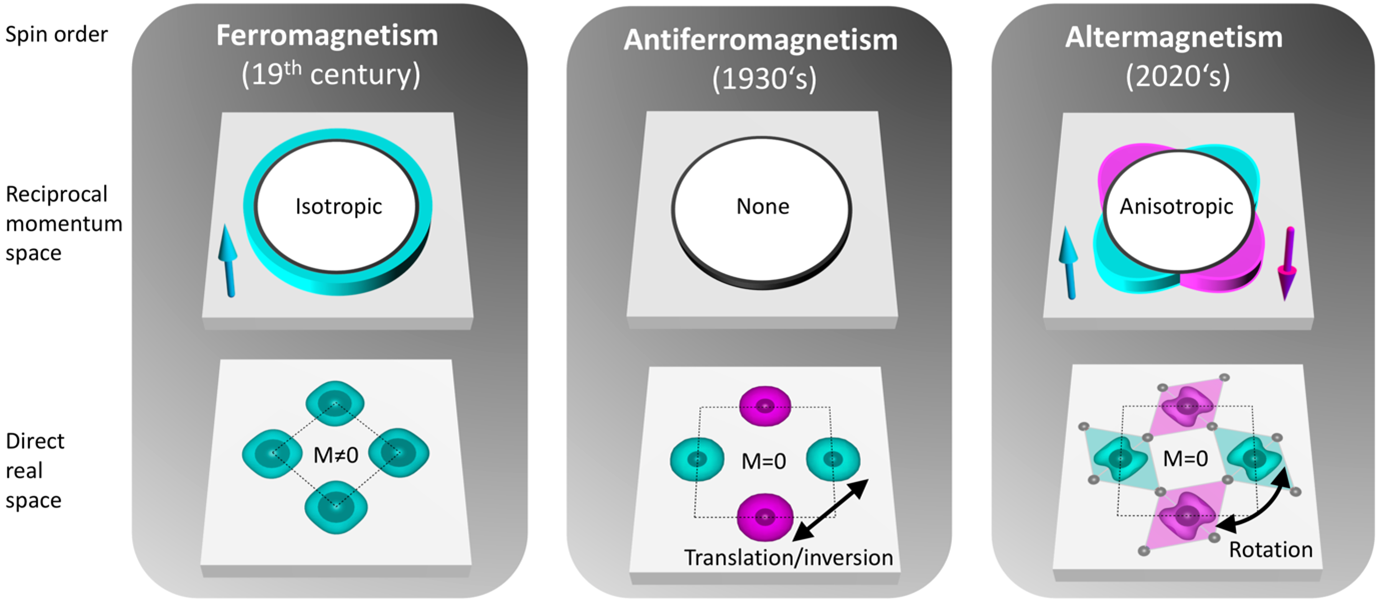There are three types of magnetism, not two, new research reveals, and the new one could be much in demand.
To the first users of compasses, magnets must have seemed a form of magic. Just when we started to think we had got a grasp on the traditional form, known as ferromagnetism, a new one, antiferromagnetism, was discovered. Now it seems our descriptions of that too are inadequate with the proof of a third type, altermagnetism. When asked, “Magnets, how do they work?” scientists have not been lying, but their answers have been incomplete.
Magnetism, when not caused by large-scale electric currents or changing fields, is an outcome of electron spins. Spin here does not literally mean electrons are rotating like planets, but refers to subatomic behavior given the same name. Orbiting electrons have magnetic moments caused by their spins, but these are usually arranged randomly. With unimaginably vast numbers of electrons in even a small item, everything cancels out, or gets so close that it doesn’t matter.
However, in rare cases magnetic moments align sufficiently to produce a large-scale magnetic field. This is only possible in a few elements, most famously iron, but when it happens it allows the familiar attraction of the lodestone to the (magnetic) north pole or the magnet to the fridge.
Antiferromagnets, discovered in 1933, usually require low temperatures and involve patterns where atoms have magnetic spins opposite to their neighbors. Without an external magnetic field antiferromagnets behave like any other material. When exposed to one, however, the atoms’ magnetic moments align in the opposite direction to their neighbors, instead of either randomly, or in a common direction like ferromagnets. This doesn’t lead to a net contribution to the field from the material, but it can lead to sharp changes in conductivity under varying circumstances, which can have applications.
If materials can march in step to magnetic fields’ commands, reject them by alternating direction or ignore them entirely, what else does that leave?
Surprisingly altermagnets provide an answer. On first sight altermagnets appear to be just another form of antiferromagnets. Their internal spins also take the opposite direction to neighbors, giving no net effect. The patterns repeat through rotational symmetry rather than translational symmetry, which means that instead of neighboring atoms canceling each other they create a spin polarization that can lead to alternating bands.
The resulting properties can provide a middle ground between the two previously known type of magnets, and may prove very useful for making magnetic memory recorders far more powerful than those that exist.
This would occur through what is known as spintronics – using electrons’ spin states, as well as their charges, to carry information. Spintronics have been worked on, and sometimes hyped, for years, using ferromagnets. However, the bulk magnetism that ferromagnets provide makes it hard to scale up spintronic devices, since the bulk magnetic field interferes with its own components spin, and those of any neighbors. Antiferromagnets avoid this, but their lack of spin-dependent effects prevents some of the behavior being sought.
Theories proposing altermagnets led physicists to wonder if they might represent spintronics’ Goldilocks zone, and to seek confirmation they do exist.
Now that confirmation has been found, some are excited enough to use a different M word. “That’s the magic about altermagnets,” Professor Tomáš Jungwirth of the Czech Academy of Sciences said in a statement. “Something that people believed was impossible until recent theoretical predictions is in fact possible.”
In 2019 Jungwirth helped identify a class of magnetic materials that didn’t fit the existing categories, carrying internal electric currents without an external magnetic field. Three years later he was part of a team that revealed more than 200 candidates for altermagnetism across diverse classes of materials. Nevertheless, there is a large gap from suspicion to proof, and at the time confirmation of altermagnetism was lacking.
However, after bathing crystals of manganese telluride, previously considered an antiferromagnet, in X-rays, Jungwirth and coauthors have announced it consists of electronic bands with alternating spin states, the key characteristic of an altermagnet.
Technically, the X-rays revealed that manganese telluride displays “Lifted Kramers Spin Degeneracy” by the magnetic order. Despite sounding like the levitation ritual of a pseudo-Medieval cult, this is actually a heavily studied characteristic of ferromagnets that was anticipated in altermagnets, but does not occur in antiferromagnets.

Comparison of ferromagnetism, antiferromagnetism, and altermagnetism, and when each’s nature was explained. The difference between translational and rotational symmetry might seem abstract, but it produces a fundamental difference between antiferromagnetism and altermagnetism.
Image Credit: Libor Šmejkal
Beyond advancing our understanding of magnetism and the potential applications it could yield, Jungwirth and colleagues think their work could provide new insights into superconductivity.
“Altermagnetism is actually not something hugely complicated. It is something entirely fundamental that was in front of our eyes for decades without noticing it,” says Jungwirth. “And it is not something that exists only in a few obscure materials. It exists in many crystals that people simply had in their drawers. In that sense, now that we have brought it to light, many people around the world will be able to work on it, giving the potential for a broad impact.”
The study is published open access in Nature.
Source Link: A New Form Of Magnetism Could Make For More Powerful Memory Devices